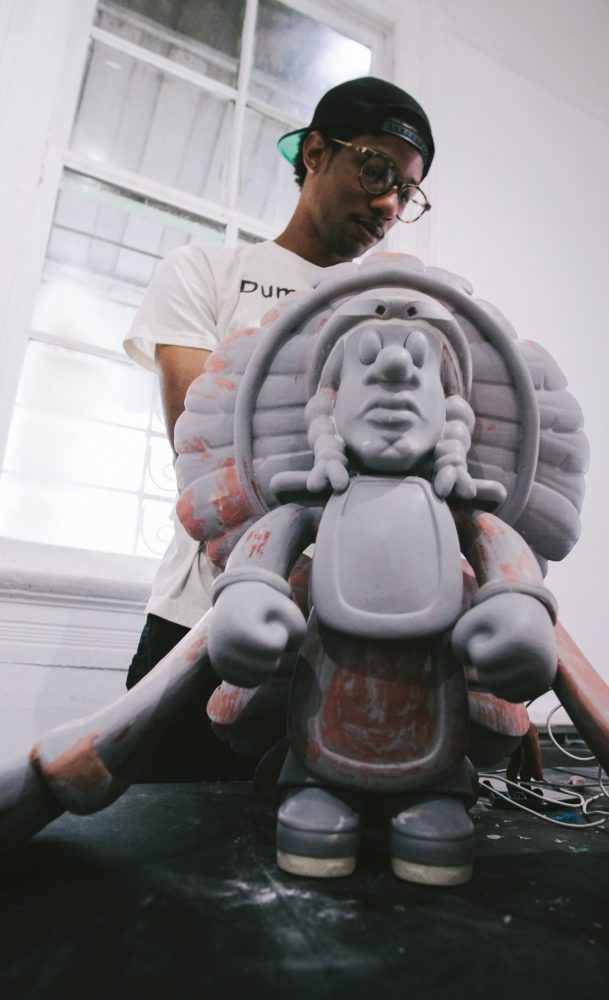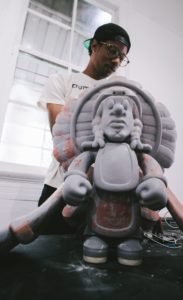Magazine
Spy Boy Toy
A new medium for Mardi Gras Indian culture
Published: March 1, 2020
Last Updated: June 1, 2023

Photo by Jamal Denzel Barnes
Compton at work on a Spy Boy figure.
Compton and I flanked his handmade toy as we sat outside in the courtyard of the Material Institute free fashion school in the Upper Ninth Ward, where Compton takes beading lessons from Big Chief Demond Melancon, leader of the Young Seminole Hunters. Compton’s departed grandfather, who masked Indian, unsuccessfully tried to bring Compton into the fold. “But my grandma didn’t allow me or my mom to mask growing up,” said Compton, pointing to the Indians’ reputation for settling disputes via gun battles back in the day. “In the times back when my grandpa was doin’ it, it was a lot more rowdy, whereas now it’s more about who has the prettiest suit,” Compton added. “Either way, my grandma was super cautious, so it just wasn’t going to happen.”
Then several years back, when Compton first began his journey as a toymaker, he looked to his grandfather and New Orleans’s Indian tradition for inspiration. “I thought that was a good time to start making an original character,” said Compton as he reached between us and lifted up his first original toy, this plastic version of the “Spy Boy” from Mardi Gras Indian culture. “I call this color Legacy Orange,” Compton explained, “because burnt orange was the color my grandfather wanted me to suit up with. This Spy Boy is me paying homage to him, and to my culture . . . This is not a regular toy, it has depth and layers to it.”
Fans of the HBO Katrina drama Treme got a primer on New Orleans’s Indians: various “tribes” of African Americans hand-sew massive, intricately beaded and feathered suits that pay homage to the Native Americans who once harbored runaway slaves. In painstaking detail, the Indian suits depict tributes to Native Americans, slave narratives, and portraits of Black revolutionary heroes. The suits are worn publicly on Mardi Gras, St. Joseph’s Night, and other select New Orleans holidays.
Tribe members occupy a range of roles that work in concert to accomplish the goal of making the Big Chief and his art look as pretty as can be. The Big Chief needs his Spy Boy to clear the way. “The Spy Boy is the frontline. You gotta go through him to get to the Big Chief,” said Compton, who explained that the Spy Boy uses a flag and various whoops and hand signals to alert the Big Chief to rival Indians ahead.
At this point, Big Chief Demond Melancon stepped out of the Material Institute’s sewing studio to join us, and he made the Spy Boy position sound just as dangerous now as it supposedly was back in the day: “Spyboy start the fights, and end the fights.” Melancon, who served as a Spy Boy for eighteen years, now commands several Spy Boys of his own—Trigger Black, Walter Black, and Reshad Brown. “The Spy Boy is more than a referee,” Melancon continued. “He’s a fire-starter. He the killer. He like Geronimo. Most of all, he gotta be ready to run.”Because the Spy Boy must remain mobile, his beaded costumes are always smaller, lighter, and slightly less elaborate, though no less beautiful. As such, Compton’s Spy Boy toy—made from thirty separate orange and brown plastic pieces that he bakes himself in his mother’s oven—is striking in its simplicity. “I didn’t want to make a Chief because this is my first project,” said Compton. “It’s real simplistic on purpose, to capture that cartoon vibe. A lot of people ask why I didn’t go super colorful, or why I didn’t just make a Big Chief. But I’m not gonna create the Chief out the gate, with my first original toy. The Spy Boy is the bottom rung, and that’s me.”
Compton, Melancon, and I talked about the ways in which New Orleans’s Indians have, especially in the last decade since Katrina, been packaged and sold by “culture vultures.” “It always seems like it’s being taken and redistributed, to me,” said Compton, and Melancon nodded in agreement. “The suits are so elaborate, and people spend thousands of dollars out their pockets to make ’em, and the only people who really profit are the photographers, who aren’t from here. I don’t too much like that.”
To that end, Compton has made a point to retain all rights to his toy, selling it (for three hundred dollars apiece) and distributing it through his own Space Broccoli company, founded in 2012 when he was just twenty-one years old to sell original streetwear designed by him and his young friends. Compton understood that, with Spy Boy, he had the power of the Indians’ story on his side—a story few people in the world had ever heard. “When anyone sees him, they’re already intrigued. Once I get to the story, they’re there for the whole ride. People love the storytelling—especially when it comes directly from us as a people. I maybe have a little magic on me too,” Compton said, smiling, and Melancon again nodded agreement. “They see me and my toy, and they just let me talk.”
Big Chief Melancon said he remains deeply impressed with the young toymaker, his strength of vision, and his understanding of and respect for Indian culture—right down to Compton’s desire to learn traditional Indian beading. “He came to class and blew my mind. I am very inspired and happy he’s here,” said Melancon. “When I first saw his toy on Instagram, wooee! I was like, ‘Is he a Indian?’ I thought he had to be. I told him he need to be a Indian. He walkin’ that path, bruh.”
Michael Patrick Welch is a musician, author, fisherman, and father whose writing has appeared in the Guardian, Vice, Oxford American, National Geographic, McSweeney’s, and a hundred other rad places.
